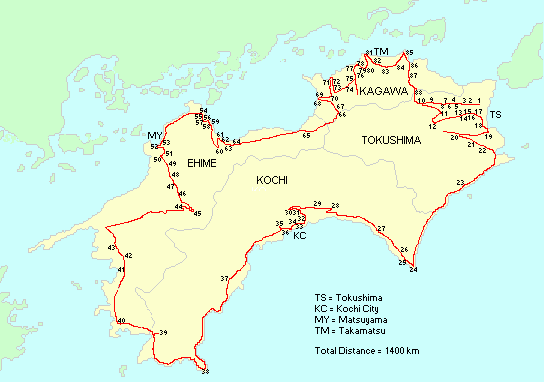We are very fortunate to share Garyo’s travelogue with her beautiful pictures again
as repeatedly before – this time Shikoku, Four States, located in the south of Japan,
a completely new world with new language, living, living systems and situations.
Please share her experiences and impressions also with your friends and families:
Dear Friends,
It is a real pleasure for me to be able to share with you my experience of the Shikoku pilgrimage as an Ohenro, a pilgrim walking the approximately 800 miles Shikoku-no-michi route around the island of Shikoku. For years, I carried the secret wish in myself to walk the 88-temple hike, until finally I could do it in spring 2016. The whole pilgrimage took me 54 days, which included a stay at the Zen temple Zuioji for 8 days.
The Shikoku Island is divided into 4 prefectures. Each prefecture has been given a Buddhist Dōjō (place of spiritual training) name:
Tokushima, Place of Spiritual Awakening
Kochi, Place of Ascetic Training
Ehime, Place of Enlightenment
Kagawa, Place of Nirvana
I will structure my report according to these four sections. However, I started and ended my pilgrimage in Koyasan, the place where Kūkai is buried and in whose footsteps every O-Henro (henro means expansive path traveling for training, honorific o is for respect for this practice, people alongside the path offer warm welcome with respects and refreshments, etc.) walks. Therefore, I will also include my days in Koyasan, a place located south of Osaka on the main island.
Due to the nature of the blog, I only can give an overview and have to leave out many details. Despite that, I hope you can get a sense of the pilgrimage and maybe want to walk it too sometime.
Koyasan (Mt. Koya), 2 Days
In the beginning of the 9th century, Kūkai (kū: sky/emptiness, kai: ocean) received permission from emperor Saga to build a monastery on Mt. Koya, a place deep in the mountains and far away from civilization. It became the center of the Shingon (True Word: Mantra) sect, whose founder was Kūkai. His teachings are based on the use of mantras, mudras and rituals. This kind of Buddhism is called Esoteric Buddhism.
Koyasan consists today of 120 Buddhist temples and is a World Heritage Site. The Okunoin, where Kūkai is buried, is the most sacred place in Koyasan. His mausoleum is surrounded by an immense graveyard, where over 200 000 people are buried. The graves are nestled in between ancient cedar trees, some of them more than 1000 years old.
An over 2 km long walkway leads to the mausoleum of Kūkai, known also as Kōbō (kō: spreading, bō: dharma) Daishi, the great teacher. It is said that he did not die but rests in eternal meditation to wait for the arrival of Miroku (Maitreya, lit. Friend) Nyorai, the Buddha of the Future. The path is lined by stone lanterns. Left and right from the path you can see many different shapes of grave markers. Even today, people want to be buried beside Kōbō Daishi. Many different big companies also have their commemoration stones here at the cemetery. One of the big pesticide companies commemorates all the insects it has killed.
Under the root of a powerful cedar tree sits a little Buddha with offerings in front of him. It is very common to offer money.
The water fountain is located near the mausoleum. It was freezing cold when I was there.
Those two Jizō (Kṣiti-garbha: Earth-wombed) Bosatsus (Boddhisattvas), guardians of children, seem to like the warmth of being cuddled together.
Entrance to one of the temples close to the Ichinohashi (First) Bridge, the “gate” entering the sacred site of the Okunoin.
This is the inner court of one of the 120 temples in Koyasan. On the left are Rhododendron bushes and a powerful group of Cedar trees. A heavy rope surrounds the group of Cedar trees, indicating the sacredness of the place. Surrounding ancient trees with a rope is a Shinto (Divine Way) tradition. Shinto is the original religion of Japan based on the veneration of nature.
Danjogaran (Hall on the Platform) in Koyasan with lecture hall, main treasure and the Konpon Daito (Original Great Tower) Pagoda originally designed and built by Kūkai in the 9th century. Due to fires, the two story pagoda has been rebuilt many times.
Here you see a row of Bosatsus (Boddhisattvas) with offerings in front of the temple Hongakuin (Original Awakening Temple) where I stayed overnight. These beings try to save all beings while training under Noyrai, the Buddha of the Future. Many temples provide a place to stay overnight in Koyasan. These places are called Shukubōs (Lodging Temples, originally for practitioners and followers, later for ordinary travelers).
Food is served in the Tatami room where you eat and sleep. Rooms in temples are often cold in winter times. Underneath the table there is a heater to keep your lower body and feet warm. The table was set for my friends Yuko and Shigeo and myself. A monk served the dinner. On the tray, every dish has its traditional place. The red lacquered bowl holds the miso soup; on the plate beside is tempura. The blue patterned dish is for rice. On the table, in the little iron cooking pots heated by a candle, a soup with different vegetables is boiling. The food is delicious.











